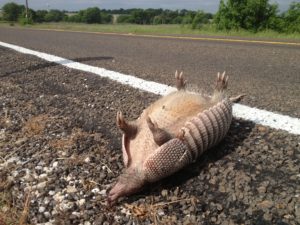 It occurred to me while traveling the backroads to the Cumberland County Playhouse a couple of weeks ago that I’d never actually seen a live armadillo. This thought came to mind because I spotted not one, not two, but three dead armadillos on that journey. As is common, all three were lying flat on their backs with their legs sticking straight up in the air.
It occurred to me while traveling the backroads to the Cumberland County Playhouse a couple of weeks ago that I’d never actually seen a live armadillo. This thought came to mind because I spotted not one, not two, but three dead armadillos on that journey. As is common, all three were lying flat on their backs with their legs sticking straight up in the air.
“Hey…” one of my travelling companions said. “Was that an armadillo?”
The first couple of times, none of us was sure. By the third sighting, we were positive the answer was yes. Which, of course, led to a conversation about why armadillo sightings seem so much more common now than they used to. Which, of course, led to me taking a deep dive into armadillo research as soon as I got home.
I learned that of the 20 species of armadillo found in the Americas, only one—the nine-banded armadillo—lives in the United States. They’re considered invasive because they compete with native wildlife for food and habitat, but they’re currently not viewed as a threat to the survival of animals that are supposed to be here. Armadillos are extraordinarily adaptable and can make their homes in forests, grasslands, sand dunes, and prairies. As temperatures have warmed and the number of predators decreased, armadillos have made their way steadily north and west and now live in most southern states and also Missouri, Kansas, Oklahoma, Nebraska, and even Colorado and Illinois.
Armadillos have a lifespan of between five and 25 years, depending partially on whether they manage to stay out of the road. They’re solitary animals, seeking the company of other armadillos only during mating season. Armadillos breed in early summer. It takes up to four months for a fertilized egg, which will break into four identical zygotes, to implant. Four months later, identical quadruplets are born. The babies nurse for several weeks and remain with their mother for about a year before setting out on their own.
Foragers that are not picky about what they eat, armadillos feed on a variety of insects and also on small reptiles and amphibians. Only when those foods are scarce do they resort to eating plants and fruits.
Armadillo is the Spanish word for “little armored one,” which is a perfect description of this unusual looking creature, which is a cousin to anteaters and three-toed sloths. They’re the only mammals that have a shell, which is made up of boney plates and is flexible like an old leather football helmet. Upon encountering a predator, an armadillo might roll into a ball to protect its soft underbelly, although only three-banded armadillos can roll into a perfectly round shape. Or it might respond in an even more interesting way. When frightened, armadillos freeze, jump straight up into the air and then sprint away, but only for a short distance.
Armadillos are excellent swimmers. They can trap air in their bellies, which improves buoyancy. Even more amazing is that they can hold their breath for up to six minutes, which allows them to sink to the bottom of small bodies of water and walk across. This is one reason armadillos have succeeded so impressively in expanding their geographical range.
The bad news about armadillos is that some carry the bacterium that causes leprosy in humans. The good news is that leprosy is extremely rare in the United States these days and is treatable. The other good news is that a person would have to have frequent and prolonged contact with an infected armadillo, or eat its meat, in order to contract leprosy. So if you’re not inclined to dine on armadillo or to take one in as a pet, you’re probably safe.
Far better to enjoy these fascinating creatures from a distance. But please-oh-please, try not to hit them with your car.
(June 26, 2021)